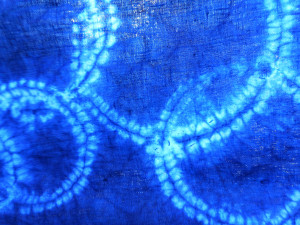
The magic of indigo never gets old, even to novice fiber artists like me. Sunday’s workshop was flat-out fun – many thanks go to Mary Ann Johnson, whose expertise in shibori and dyeing greatly enhanced our experience. The weather was perfect – our fabric dried quickly in the breeze and the sunshine on our makeshift clothesline.
Here are the basics of how we did it:
The fabric is tied, clamped, rusted stitched, crumpled – any or all. Then it is submerged slowly into the indigo vat for about a minute. The bound fabric is gently removed from the dye bath, avoiding splashing or dripping into the vat, as this introduces oxygen back into the dye. The fabric looks green when you first take it out of the bucket. This is when the magic happens (or to be more precise, chemistry). Indigo develops its color when it is exposed to oxygen. Once the fabric is in contact with the air, it starts changing color and turns from green to blue. You can see some of this happening in the video, below.
If you are new to this process, I highly recommend that you start with the Jacquard Indigo Kit. It has everything you need to make true indigo plant-based dye. The video below, from Jacquard, shows how to do it.
Things to watch out for – holes in rubber gloves! The biggest danger, though, is addiction to indigo dyeing, particularly when you realize it can also dye paper and yarn.
I can’t wait to cover some journals with my indigo fabric, and perhaps combine indigo-dyed paper with encaustic. It’s true blue indigo love!


The most beautiful blue magic!
Thanks, Debbie – it’s really fun and addictive to watch that color change from green to blue – ♥
Great class!
Thanks, Linda – it’s always so good to work with you – can’t wait for our show.